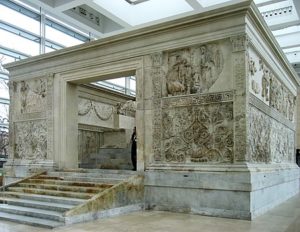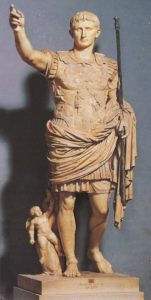The Ancient World showed the progression of art beginning with Egypt, onto to Greece and then into Rome. In Egypt, animals and human were much more “abstract” in comparison to the progression of human sculpture in Ancient Greece. Egypt revolved around pleasing the Gods, so naturalism, although present, was not as accurate or important in their artwork. In fact, if you compare Kouros of Attica (Egypt Sculpture of a young boy) in comparison to Greek Anavysos Kouros, the Egyptian sculpture is much more rigid and less anatomically detailed. Anavysos is much more refined and progressively naturalistic. This reflects the philosophy presented by the Greek and later adopted by the Romans, known as humanism. Humanism was the shift of a God-centered society in a Man-centered society.
The fixated interest on naturalism, especially of the male body, reflected these beliefs and caused a trend of improving this naturalism of the human body in their artwork. Although there are few Greek bronze sculpture left to show this progression, Romans exclusively transduces Greek bronze artwork into marble. This marble showed a much more human-like posture known as contrapposto and the increased use of the S-curved body that help push this idealized body. In fact, this desire to push the limits of idealistic bodies progressed into the famous Hellenistic period which shifted from perpendicular art into diagonal and emphasized emotion, action and the humanistic ideas. In fact, it was beyond an ideal body and control, but the naturalism of a human in both body and psychology. This can be shown in the major difference between The Dying Gaul and the Doryphoros. Although the Doryphoros tries to capture human psychology and has contrapposto, The Dying Gaul captures the emotion of a dying man, leaning on one hand while almost lying down and in a diagonal position. This is a much more theatrical storytelling piece than the Doryphoros which is just a showing of an athletic idealized man.
Romans then move on from copying Greek sculpture and progress into portraiture, in order to show that art is much more than deception, but can show the truth. This is called Verism and was developed after the criticism of Plato in Plato’s Republic in which he calls art deceitful and fake. Therefore, artwork progressed into a tool for many customs, but always in a naturalistic form. In fact, much like the Egyptians, Romans used art for funerary rituals. The difference was that Roman artwork was the epitome of naturalism. The Roman Patrician with the bust of his Ancestors, in comparison to Tutankhamun’s Death Mask, is much more naturalistic and representative of the man holding his ancestor’s death mask. Tutankhamun’s Death Mask is much more symbolistic. It is not to say that Romans did not use are in to idealize or refine an idea. Much like Greece for humanism, Augustus Caesar used art to portray power; almost as propaganda with a political purpose. I could continue on (Roman Art Paintings, Ara Pacis Augustae), but in conclusion, although art did progress there was a period of regression when many cult religious were introduced as the Roman empire increased in size.



